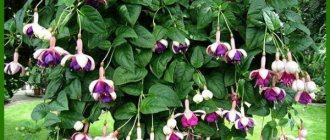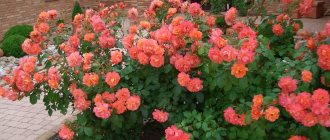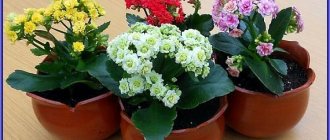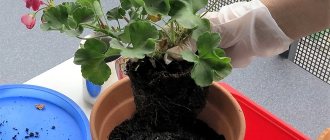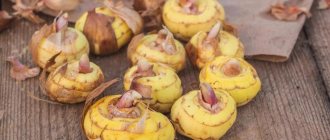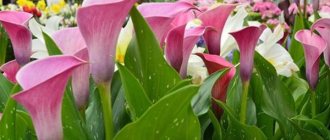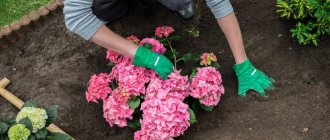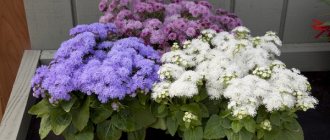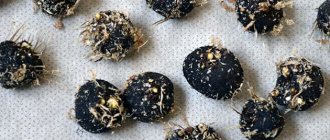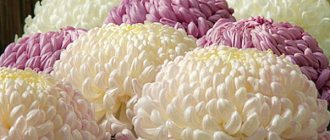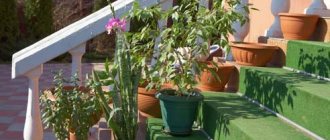When can you plant geranium (pelargonium) outside in open ground? Experienced gardeners recommend replanting in late spring. Both garden varieties and indoor plant varieties are allowed to be sent outside. All types of flower crops will be able to take root normally in a new place, covering the bush with beautiful and bright flowers.
Below you can find out which varieties are allowed to be planted in the ground and when it is permissible to carry out the procedure, in what ways the crop can be propagated, and also how to plant a flower in a decorative pot.
Types for planting in the ground
Often indoor types of geraniums are planted on the balcony or windowsill at home. They look impressive and grow well both in home flowerpots and in open ground outside.
It is best to plant flowers for the first time in the spring, and then in the summer. To do this, either shoots grown in the fresh air are taken, or cuttings from rooted shrubs are used. In the spring season, the root system of geranium is perfectly divided into several parts.
Summer planting takes place in the middle of the season, when the rains stop. Transplanted flower crops need plenty of moisture, as well as shading for 3 weeks from the moment of transplantation.
The buds of garden varieties of geranium can be painted in various shades. The flowers are either collected in spherical inflorescences or develop singly. The leaves have a greenish color with an ashy or whitish tint around the edges and a lemon aroma with a slight smell of mint.
Is it possible to plant royal geraniums outside? Experienced gardeners claim that this indoor flower simply cannot be kept in the open ground in the country house or garden all year round. It is advisable to breed it only as a house plant. But in the summer, indoor royal geraniums are allowed to be placed on the veranda or balcony. And when the autumn season comes, then the pots with the plant will need to be brought back into the house, where the warm temperature will remain.
Why do I grow geraniums in open ground?
Geranium is one of my favorite flowers, so it’s no secret that it brightens up my garden. Pelargonium is not only beautiful and bright, but also unpretentious in comparison with the “queen of the garden” rose. But when choosing a new variety, I study the description - the plant must be adapted to our climatic conditions.
perennial garden geranium
If you decide to grow geranium in your flower garden for the first time, I can recommend several varieties that you will definitely like:
- Ashy. I’ll start with the most unpretentious variety of geranium - it takes root well not only in the middle zone, but also in the northern regions. A low plant with ash-colored leaves - hence the name. The flowers themselves are bright pink with white centers. Ash pelargonium is preferred for decorating borders.
- Lugovaya. This geranium with the largest inflorescences is like blue saucers! I recommend this variety for open, sunny areas. Do not choose meadow geranium unless you can provide the plant with consistent, frequent watering.
- Himalayan. The most versatile pelargonium you will find in garden stores. It is used to decorate gazebos, plant them along borders, and on flower beds as a continuous “carpet.” Himalayan pelargonium blooms well and develops even in shaded areas. And the esthete’s eye will be delighted by its raspberry-lilac double blooms.
- Clark's geranium. An excellent choice for owners of plots in lowlands, where there is a high degree of humidity even in dry summers. Clark's Pelargonium is a plant with thin stems and beautiful large leaves. The petals of the inflorescences are soft blue, pleasant purple.
- Spotted. It grows into a large bush, rising 50 cm. The flowers are real snow-white or blue “bowls”. For spotted pelargonium to develop well, plant it in an open, well-lit area.
General timing for planting geraniums
Since ancient times, geranium has been especially popular among gardeners who like this flower for its beauty and ease of care. The geranium bush is often cultivated in decorative pots on loggias and verandas, in the front garden, as well as in flower beds in the garden. The general planting time is in the spring.
What is noteworthy is that the flower is characterized by excellent ground cover qualities, and can also act as a recultivator, that is, contribute to the restoration of the soil layer. In this regard, pelargonium is sent to the flowerbed not only to decorate the garden landscape, but also to improve the soil composition.
It is very important to know when to plant the crop outside, since geranium prefers warm weather.
Note! The plant should be sent into fresh air when the ground warms up normally and the thermometer does not drop below zero.
For the middle zone, geranium planting occurs at the end of May. However, it is worth noting that pelargonium can be propagated both by seeds, bushes, and layering. The planting time for each type of planting material will be different.
Pelargonium zonal: how to grow in the garden, varieties and photos
The largest and most diverse group of pelargoniums are zonal. They come from the zonal pelargonium species (Pelargonia zonale), with a dark concentric pattern on the leaves. Almost all plants in this group can be grown not only on the windowsill, but also outdoors as an annual plant from May to October.
Pelargoniums zonal Eve and Orange Ice in a garden container
- Pelargonium zonal: how to choose a place in the garden
- Zonal pelargoniums for open ground and garden
- Recommended varieties of zonal pelargoniums for the garden
- Conditions for growing zonal pelargoniums
- How to water and feed zonal pelargoniums
- Cuttings of zonal pelargoniums
- Possible problems when growing zonal pelargoniums
Pelargonium zonal: how to choose a place in the garden
In the garden, zonal pelargoniums look beautiful in flower beds and parterre compositions. They can be placed in large pots throughout the site or planted in original containers - old basins, pots, cans and wooden barrels.
Pelargoniums thrive in large flowerpots and containers
Zonal pelargoniums go well with fragrant pelargoniums or herbs and look great against the backdrop of a neat green lawn. It is better if there are no other bright flowers next to the pelargoniums, then the beautiful pattern of their inflorescences will not be lost.
In the garden, it is better not to mix pelargoniums with brightly colored plants.
For example, luxurious flower beds with red pelargoniums at Buckingham Palace in London are framed by ideal lawns and decorative foliage plants. It looks very solemn: like ribbons of the highest awards of the kingdom.
Zonal pelargoniums for open ground and garden
According to the type of growth, varieties of zonal pelargoniums are standard (average plant height 30 cm), dwarf (up to 20 cm) and miniature (12–13 cm). It is recommended to keep the latter under shelter from the rain - their delicate small bushes need to be protected from changeable weather conditions.
As a rule, plants of the standard type are planted in open ground. A bright place is chosen for them, but preferably not in the sun. Some varieties of pelargonium, especially variegated ones, do not like direct sun - the beautiful ornament of their leaves fades. It is also not recommended to get too carried away with varieties with white flowers - in the event of prolonged rains, their bushes with rotten inflorescences will look extremely unattractive.
Pelargoniums with snow-white flowers may suffer from rain
Recommended varieties of zonal pelargoniums for the garden
Pelargonium inflorescences may suffer from rain. Therefore, in plantings in open areas, rather unpretentious varieties of PAC selection are often used, such as Shocking Violet, Сalais, Blue Wonder, Emilia, Victor, Robe, Salmon Queen and others.
For greater effect, you can plant variegated varieties of zonal pelargoniums, the colorful leaves of which will compensate a hundredfold for the modest flowering of their non-double flowers. In natural light, the contrast of the leaves of such pelargoniums appears much better than in greenhouses or on a windowsill.
Pelargonium x hortorum, Zonal Geranium Indian Dunes
But you need to remember that in the scorching sun their shades can fade. The color combinations of pelargoniums with variegated leaves are very different - gold, two- and three-color, and even with a “butterfly” pattern in the center of the leaf, like the Happy Thought variety.
Not all variegated varieties are suitable for outdoor use. Some are quite capricious even in indoor conditions and grow very slowly, so in the garden it is better to experiment with the more unassuming Butterfly Lorely, Distinction, Pink Dolly Varden, Hill's of Snow, Mr. Henry Cox, Contrast and the well-known star-shaped zonal pelargonium Vancouver Centennial.
Pelargonium x hortorum, Zonal Geranium Velma Cox, also known as Mr. Henry Cox
Beautiful harmonious bushes are formed by the variegated pelargonium Madam Saleron, which never blooms. And I would also pay attention to the Medalion and Occold Shield varieties - they have a horizontal growth pattern and very beautiful foliage with a golden-green base and a wide brown-burgundy zone.
Pelargoniums of the Deacon variety series form beautiful inflorescences. Deacon Coral Reef, Deacon Moonlight, Deacon Finale will look beautiful in the garden. They are best kept in pots and garden boxes. Well, if you want something unusual, try rose-flowered pelargoniums. They will bloom beautifully in large flowerpots on the leeward side of the house. The most famous old varieties are Apple Blossom Rosebud and Denise. And among the relatively new ones, I would highlight Swanland Pink Rosebud and Rushmoor Golden Rosebud.
Pelargoniums and marigolds in the foreground of an extended flower garden along the path
Conditions for growing zonal pelargoniums
Pelargoniums are quite loyal to the composition of the soil. On loamy and sandy loam soils, they will bloom well everywhere if the necessary agricultural practices are followed. It is advisable to avoid areas where water can accumulate - here pelargoniums will develop poorly and become sick. An alternative to open ground can be container keeping - pelargoniums will look great in large pots, flowerpots, garden boxes or hanging baskets. In this case, the soil should be well-drained and nutritious.
Pelargonium bushes that have grown up and are ready to bloom can be planted in the garden in late May - early June, when the danger of night frosts has passed. When planting, the root collar may become slightly deeper. Try to bury part of the stem into the soil - young roots will begin to grow from its base, which will have a beneficial effect on the further development of the plant.
Planting pelargonium seedlings in the ground
How to water and feed zonal pelargoniums
In summer, pelargoniums require regular watering. It is advisable to water the plants either in the morning or in the afternoon, after 5 o’clock. In hot weather - every day, on cloudy days - as needed. It must be remembered that in hot weather you cannot skip watering. During the period of growth of young rooted plants in pots and the formation of a bush, it is necessary to fertilize 1-2 times with a complex fertilizer with a predominance of nitrogen. In the future, in the summer, it is better not to use this fertilizer for bushes planted in the ground.
Caring for pelargoniums is not difficult
During the flowering period, pelargoniums will form more flower stalks if you add fertilizer with a high content of phosphorus and potassium once every two weeks when watering according to the manufacturer's instructions. You can also use organic fertilizer in the same way as for other flowering plants. For pelargoniums in containers, I alternate watering with the recommended dose of fertilizer and half of this dose per feeding. You can also use fertilizer for succulents. Interestingly, English experts advise using tomato fertilizer for pelargoniums - it really does a great job of stimulating their flowering.
Cuttings of zonal pelargoniums
In spring, young pelargoniums are sold in all garden centers. But you can also take care of your own seedlings to save your favorite varieties for the garden next year. To do this, in August-September, take cuttings from strong and healthy plants. They will take root fairly quickly in water or a mixture of peat and perlite. Then they are first transplanted into small pots with a diameter of up to 8 cm and, as they develop - in January-March - into peas 12-15 cm. And in May-June, rooted pelargoniums are planted in the ground or containers.
Pelargonium zonalis Divas Ripple Mixed
Mature bushes can be dug out of the ground at the end of September and kept in pots until the new season in the house. For wintering, it is better for them to choose a cool place (ideally +12...+16 C) and water them moderately. In February, wintering bushes need to be pruned so that they produce more new shoots, leaving 3-4 buds from the base of the stem to stimulate the growth of new shoots. To prevent the plant from experiencing too much stress from pruning, I sometimes only shorten half the stems first, after making sure. Since the new buds have started to grow on them, I cut off the rest. There is an opinion that pelargoniums reveal their greatest flowering potential in the first 2-3 years of life, so it is better to renew adult bushes after 3-4 years by taking cuttings for new plants.
Pelargonium zonalis Toscana Tammo
For more information on how to easily and quickly cut pelargoniums, see here >>>>>
Pelargoniums for the garden can also be propagated by seeds - I prefer to sow them in December-January, but you can also sow them in February-March. True, the seedlings will have to be carefully looked after - kept in the brightest place, including under lamps, so that they do not stretch. As they grow, around April, the seedlings will need to be transplanted into larger pots and pinched to develop fluffier bushes. If the plants have nevertheless formed a rather long main stem, it can be buried 2-3 cm when planted in open ground or cut to the desired height.
Seedlings of zonal pelargoniums grown from seeds
Possible problems when growing zonal pelargoniums
Pelargoniums are practically not susceptible to pests and diseases if the basic conditions of their maintenance are observed. With excess humidity and low temperature in plantings with poor ventilation, gray rot and mold can develop on leaves and stems. Among the insects in the garden, they may be bothered by aphids, slugs, snails and caterpillars. Methods of dealing with them are generally accepted. Otherwise, caring for pelargoniums is very simple - for a beautiful shape and constant lush flowering, it is necessary to remove dried leaves and wilted inflorescences along with peduncles.
Zonal pelargoniums are incredibly diverse and stylish plants. You can find a lot of useful information about their varieties, propagation and cultivation, as well as garden design ideas on Ekaterina Kotskaya’s website: www.pelargonium-club.ru
Zonal pelargoniums are traditionally grown in hanging pots
Types of planting material
Geranium can be propagated in different ways. Overgrown shrubs can beautifully decorate a flower bed, as well as expand the overall area of the crop, giving the flower garden even more attractiveness.
What is noteworthy is that although pelargonium is considered a houseplant, it has adapted so well to various growing conditions that, depending on the type of planting material, it can be propagated using several methods, namely:
- In divisions. In this case, the bushes may become covered with flowers 3 weeks after planting. To obtain divisions, the geranium must be removed from the pot and divided into several parts, each of which will have its own stem.
- Seeds. This method of obtaining seedlings is considered difficult and is not particularly popular. Small, fragile sprouts are very demanding to care for. Seedlings can wither in a short period of time either from extreme heat or from waterlogging. At the same time, if you plant geranium seeds in open ground, the bush will be able to bloom only after a year. Only a two-year-old crop grows from seeds.
- By cuttings. Planting material is cut from old flowering shrubs. In this case, the upper part of the plant 15 centimeters long is taken. There should also be a couple of leaves on the cuttings. Thanks to cuttings, the plant will be able to bloom in the year of planting, but only in the fall. The bush can also bloom in winter on the windowsill.
Propagation by divisions, unlike other methods of breeding pelargonium, makes it possible to obtain viable and strong planting material.
Planting and care
Garden geranium takes root very quickly. The hole for the plant must be made in such a way that about twenty centimeters of loose soil remain under the longest of the roots. There should be a distance of at least thirty centimeters between the holes. Before planting, the plants must be disinfected and the cuttings treated with root.
The first year after planting there will be few leaves, so it is better to mulch the ground around the bushes to protect the flowerbed from weeds.
Perennial geranium is a non-capricious plant that has retained the ability to withstand adverse conditions, diseases and pests. Therefore, you only need to maintain its growing conditions in a well-groomed condition.
The plant tolerates drought, but if you want to observe its lush growth and abundant flowering, then water it as the soil dries out.
It is not necessary to prune geraniums after flowering. Already yellowed inflorescences fall under the foliage without spoiling the appearance of the flower garden. But, if you want to prolong flowering and make it abundant, then periodically it is worth cutting off wilted buds to allow new ones to appear.
Later, from the bursting fruits, seeds will fall to the ground, which will sprout next year. If you don’t want to deal with thinning the bushes, you can immediately remove the seed pods.
Geranium leaves contain a large amount of essential oils with phytoncides, the aroma of which pests cannot tolerate. This is an excellent way to fight insects not only in the flower garden, but also in vegetable beds, where you can plant geranium bushes for this purpose.
Watering
Any variety of geranium loves regular, but very moderate watering. You need to water the plant especially carefully in the first months after planting. You need to slightly increase the amount of water during dry periods. You can determine the lack of moisture by the leaves of the plant, which begin to droop. There is no need to spray geraniums.
Fertilizer application
Fertilizing geraniums is carried out in the spring with nitrogen fertilizers. After 25-30 days, the bushes are fed again with complex fertilizers containing potassium and phosphorus. But there are varieties that do not need fertilizer in such quantities.
Geranium can grow in garden conditions for up to ten years. It is not demanding on the composition of the soil; it can grow in the sun and in the shade, depending on the variety. The plant does not require complex care or special attention; it overwinters quietly without special shelter.
Geranium is used not only in landscape design, medicine, but also in the manufacture of perfumes. And if you put geranium leaves in a jar of jam, it can last for a very long time. Therefore, don’t even think twice about it, plant geranium and enjoy its beauty!
Time for planting seeds
Planting geranium seeds in open ground outside will require more time and effort to produce a beautiful flowering shrub in the future. As for planting dates, seeds should be planted at the end of May, when heavy rain has passed and the soil has warmed up normally.
The emerging shoots will be very weak, so they will have to be thinned out a little. The distance between seedlings should not exceed 5 centimeters. After this, the seedlings will need to be planted at a distance of 40 centimeters from each other, or simply thin out the rows. The resulting bushes will become strong and bloom for 5 years. In the first year after planting, the plant does not bloom.
Due to the seed method, the seedlings will be weak, which can subsequently lead to the plant freezing.
April is suitable for planting pelargonium seeds in a pot. Initially, planting material is planted in one container. When the seedlings form (appear 18 days after planting), the seedlings are distributed into separate plastic cups with a light soil substrate. Planting in the ground is carried out only when the bush has normal roots.
Often, seedlings are planted in mid-May. Shrubs should be planted at a distance of 40 centimeters from each other. The culture begins to bloom from the next season.
Preparing the plant, soil and conditions
Usually a cutting from an adult healthy bush is planted in open ground. But you should not “stick” a freshly cut cutting into the ground, as it may simply die.
First of all, the seedlings are prepared - the sections are treated with activated carbon or ash, and then the cuttings are kept in a solution that stimulates root growth. It turns out that the cuttings need to be separated from the adult bush three weeks before planting in the ground. As for an adult plant, no preparation is needed; it is simply carefully removed from the flowerpot and transferred to a prepared place.
The soil is prepared as follows:
- In the fall, during digging, mineral fertilizers are added to the soil; if possible, you can add humus and only then dig.
- Before planting geraniums in open ground, the soil is acidified - you can use citric, oxalic acid or ferrous sulfate.
- The soil must be provided with good drainage.
- Place in the hole in layers: peat, sand, garden soil. If you can’t prepare such a mixture yourself, you can buy a ready-made one in the store.
A hole for geraniums is dug based on the size of the root system - the roots should be positioned freely. In addition, it is better to choose a bright area, but not exposed to direct sunlight.
When and how to plant cuttings?
To properly plant geranium cuttings, it is recommended to adhere to the following conditions:
- If the cut cuttings are immediately planted in open soil, the planting material must be prepared in late spring. In this case, the cuttings must be dipped into a growth stimulator, then the wet stem should be sprinkled with ash or crushed charcoal. After this, the cuttings can be sent into the ground. It is worth clarifying that it is necessary to dig a hole for watering near the planted cuttings.
- If the cuttings are still growing, then the cutting of the planting material occurs after the 10th of May. Then the stems are immersed in water for a couple of weeks, and then planted on the site.
Thanks to this method, the bushes will begin to bloom after 1.5 months. Closer to the autumn period, the plant will normally take root and take root, which will enable the crop to withstand the winter cold well, but only with shelter.
Preparing the soil and planting geraniums in open ground
In addition to the planting material itself, I prepare the flower bed. It is best to choose a zone for geranium:
- with an airy, soft, light substrate;
- without direct sunlight (depending on the variety);
- with warmed and pre-moistened soil - great if there were heavy rains before planting.
Flower beds for pelargonium need the following treatment:
- In the fall, I carefully dig it up, simultaneously applying complex mineral fertilizer.
- Before directly planting pelargonium, I slightly acidify the soil. You can use both oxalic acid, citric acid, and iron sulfate for these purposes.
- Geranium prefers drained posts. So I try to loosen the soil very, very carefully. If it has managed to compact well over the winter, it is better to start by digging it onto the bayonet of a shovel.
- Spread a 5-10 cm layer of rotted compost over the surface of the already prepared flower bed. Mix it with garden soil.
- Now is the time to make holes for geranium seedlings - a 25-centimeter depth is enough. If you are already planting large bushes, make sure that the root system both in length and width fits freely in the hole. Otherwise, the plant will not grow and develop at all.
- I fill the bottom of each hole with a 1 cm layer of peat-sand-compost mixture.
The transplantation of seedlings itself follows the following scheme:
- Place the previously prepared bush and the cutting into the hole. If it is a bush, inspect its root shoots for damage.
- Sprinkle with soft fertile soil, lightly compact the substrate at the base of the plant stem.
- Pour water heated under the sun - generously, but not so much that a “swamp” remains.
- If you are replanting more than one cutting or bush, then plan planting according to the following scheme: between cuttings - at least 20 cm, between mature and developed bushes - already about 60 cm.
Planting bushes
The simplest and easiest way to propagate pelargonium is considered to be propagation by bushes. The delenks are received at the end of May, when the warm rain passes. If it is still cold in May, propagation must be postponed to a later time by planting shrubs in June. The plant quickly takes root, forms and blooms.
Before planting, pelargonium while still in the pot needs to be well moistened. After this, the flower should be removed from the container and shaken off the soil. The root system must be divided into several parts, each of which must have a stem with leaves.
The resulting seedlings are sent to pre-dug holes and watered. If the plant is cultivated in a sunny area, the flower should be slightly shaded.
The bush will begin to bloom 21 days from the moment it is sent to the soil substrate.
Caring for a flower outside
If you follow all the rules for caring for pelargonium in open ground conditions, you can achieve flowering already in the first year after replanting.
The key to success in obtaining a beautiful garden specimen of a flower can be proper watering. It must be done regularly and in moderation. It makes it no more difficult than growing a plant at home. After planting and during the first months of active growth, more frequent moistening of the area is required . But there is no need for spraying.
Also, we must not forget about feeding. It is recommended to apply nitrogen fertilizers for the first time immediately after planting. Thanks to this, pelargonium will be able to increase its leaf mass. A second feeding will be required in a month. This time, for the procedure, you need to stock up on complex fertilizer, which includes potassium, phosphorus, nitrogen and microelements. But it is better to refuse organic matter, since it can cause garden pests.
Reference . Don't forget about pruning bushes. In order for the plant to begin to actively grow and delight you with lush flowering, the tops of the shoots should be pinched a little.
What to do in winter?
A slight decrease in temperature at the beginning of autumn is not capable of harming heat-loving pelargonium . But the first frost can destroy it. Therefore, October is the right time to move the plant from open ground indoors.
Before this, pruning and replanting of bushes is carried out:
- The shoots above the node are cut with a sharp knife, leaving no more than 15 cm. The dried greenery is removed.
- Next, the plant is carefully dug out of the ground and transferred to prepared pots, which should already be filled with drainage and garden soil with sand.
- The distance between the bushes is no more than 25 cm. If separate containers are stored, then their diameter should be at least 30 cm.
- Plants prepared in this way are placed in the basement.
Throughout the winter you need to monitor the humidity and temperature in the room . As it dries, moderate watering is necessary.
For successful wintering of pelargonium, it is necessary to provide sufficient lighting.
Time to plant in pots
Geraniums can be beautifully planted both in huge flowerpots in the garden and in pots on the balcony. Sometimes several types of pelargonium, with flowers of different colors, are planted in one pot at once. The most suitable time for planting is spring.
Planting a crop in a pot is relatively easy. In the spring season, you can transplant whenever it is convenient. However, care must be taken to ensure that, if necessary, the pots can be brought into the house or covered with something if the temperature drops to zero. Rooted geranium can withstand a slight cold snap, but the plant does not tolerate frost.
Note! In order for flowers to take root well in a new place after transplantation, planting must be done before the plant begins to bloom. If the pelargonium has bloomed, it is advisable to postpone the transplant to another date, otherwise the plant may die.
Recently transplanted and already established flowers are allowed to be sent outside only at lunchtime. When the evening frosts end, it is permissible to leave the flower pot in the open air for the whole day.
A plant in a pot needs to be moistened much more often than in open ground. This is due to the fact that the container contains a small volume of soil substrate and the pot is heated from all sides.
What pots can geraniums be planted in? It is better to choose containers made of clay, since in such pots the moisture evaporates much faster, which prevents rotting of the root system. In addition, clay helps to wash out salts from the soil, which can harm seedlings. As for the size of the container, you can take a small pot in which the geranium can bloom for a long time. Small containers are suitable for young sprouts. In large pots, pelargonium will be able to grow greenery and develop a root system. The optimal pot for flowering geraniums is one with a diameter of approximately 14 centimeters and a height of 15 centimeters.
Why did the geranium planted in spring turn yellow? This can happen for several reasons:
- a very cramped pot is used in which the roots cannot develop normally;
- there is no drainage layer in the container;
- the plant is experiencing moisture deficiency.
Also, the cause of yellowing of the leaves of a flower may be an excess of nitrogen in the soil.
Description of the plant
Geranium (Geranium L.) is a genus of perennial or annual plants from the geranium family. The genus contains approximately 300-450 species. These include annuals, perennials, and less commonly subshrubs and shrubs. They are found on almost all continents; in the tropical zone they grow in the mountains. The greatest diversity is found in the temperate climate zone. There are about 40 species in Russia, some are also cultivated as ornamental plants.
Geranium or crane flower has a special charm. It is hardy to various conditions and grows easily. However, different types of geranium have different requirements that must be taken into account when growing. There are varieties for shady, semi-shaded and sunny areas, low, medium and tall, varieties that fit beautifully into flower beds, and those that will decorate rocky gardens and a forested corner of the garden. Neither species will require much effort other than choosing the right planting site and providing basic growing conditions.
Geranium has several hundred species and grows on most continents. In our area you can find more than a dozen varieties, some of them are grown as ornamental plants. Several species can also be planted in gardens.
Geranium (Geranium) is quite closely related to pelargonium, although it does not bloom as grandly, but you can see the similarities in the shape of the leaves and flowers. In English and German, pelargonium is usually called geranium (that is, the botanical name for geranium). Once these plants belonged to the same species, but then they separated.
The name geranium comes from the Greek word geranos or γερανός, meaning crane, because the geranium fruit is associated with the beak of a crane. The English colloquial name for the plant is cranesbill.
Botanical characteristics:
- Leaves. Solitary, dissected, often lobed, rarely pinnate, collected in a rosette, stem, usually opposite, with stipules. Leaves on distinct petioles. The leaves of some species turn beautiful orange and red in autumn.
- Flowers – have different sizes, but always consist of 5 petals. Rarely grow singly, more often in pairs from leaf axils or at the apex, forming a complex apical inflorescence. The sepals overlap each other, blunt or long, pointed at the top. At the center of the flower is a spectacular pistil surrounded by ten stamens. The filaments of the stamens are often expanded and pubescent at the base. Petals come in different colors. The flowers grow on stalks and are usually very numerous, which compensates for their delicate appearance.
- Fruit. They contain 5 individual seeds and are shaped like a crane's beak. When ripe, they burst and fly away. The special hooks they are equipped with can be attached to animal fur.
Varieties with colorful and patterned leaves are becoming more popular.
The form of a geranium bush is:
- crested – species Geranium cantabrigiense, Geranium himalayense;
- flat spherical – species Geranium macrorrhizum, Geranium sanguineum;
- cushion-shaped – Geranium endressii, Geranium dalmaticum.
In autumn, plants take on different colors:
- red – for example, Geranium pratense variety “Midnight Reiter”, Geranium sanguineum variety “Max Frei” Max Frei;
- orange – Geranium macrorrhizum variety “Pindus” Pindus;
- yellow – Geranium oxonianum variety “Johnson”, Geranium renardii;
- do not lose color – Geranium pratense variety “Silver Queen”, Geranium himalayense variety “Irish Blue” Irish Blue.
Site and soil preparation, care
Pelargonium, like other types of flower crops, prefers to grow in places with diffused lighting, that is, so that the sun does not constantly shine on the plant. After the shrubs or cuttings are planted in the ground, they will have to be hidden from the sun for some time and also regularly moistened. It is recommended to water only in the morning. Due to this, the roots will not rot.
The substrate must be loose. You can add fertilizer or sand to the soil. The bushes will need to be placed in the ground to the same depth as in the pots. After planting, the soil around the seedlings must be mulched.
The dug hole can be watered with an aqueous solution of citric acid (a teaspoon of the substance is required for 3 liters of liquid).
The size of the dug hole should be larger than the size of the pot. This will make it possible not to deform the roots of the plant during transplantation.
Further maintenance of the flower
It is worth immediately indicating that for the first 14 days after transplanting into open ground, the plant must be protected from direct sunlight , that is, the planting bed must be shaded. In addition, you should follow the following rules for caring for geraniums after transplantation:
- Remove weeds around bushes.
- The optimal soil temperature should be within 15-20 degrees - it should not be overheated or waterlogged.
- Insecticides should be used to protect against pests.
- Leaves should never be sprayed.
- Fertilizing is carried out once every two weeks - use mineral fertilizers.
- Before applying liquid fertilizers. Geranium is watered well - otherwise the root system will burn.
- If the plant remains in the ground for the winter, then before frost it is necessary to prune it - each stem is shortened by 5 cm.
More often, geraniums are grown in pots and therefore we have articles about transplanting geraniums into another pot and about planting a shoot without roots.
Preparation of planting material
Before transplanting seedlings or geranium cuttings into the soil, the seedlings will need to be hardened off approximately seven days before. Every day you will need to take the planting material outside to the area where you plan to plant the plants, or you can artificially create conditions that will be in the country.
Pots or other containers with seedlings can be left overnight if the temperature outside does not drop below zero around the clock.
Thanks to hardening, planted flowers adapt better and faster to new conditions. In this way, you can achieve high and lush flowering throughout the summer season.
Planting process
Previously cut cuttings and planted in cups that have been hardened are taken outside and left until planting.
The landing process then looks like this:
- Digging a hole.
- Planting a bush and covering it with soil.
- Lightly water and compact the soil around the seedling.
- Pinching the apical bud to subsequently form a dense bush.
During rooting of the seedling, you need to tear off its lower leaves, otherwise they will still turn yellow. To get a rolling bush, you need to pinch every 10th apical leaf, and do the same with the side shoots.
Planting a plant in summer
If you plan to plant the plant in the summer, it is preferable to use the method of dividing geranium bushes. This procedure is suitable for varieties that grow exclusively in open ground, as well as for those that need to be distributed into pots with the arrival of the autumn months. In summer, the roots of the plant are loose, so you can get divisions much faster without deforming the plants.
You can transplant the crop from a pot into open ground from May to August.
Summer planting from early to mid-August is suitable for those flowers that do not need to be dug up. Transplanted shrubs need to be well moistened and carefully protected from direct sunlight using cut branches with leaves.
The plant should not be replanted in new places after the due date, otherwise the crop will not have time to take root properly before the arrival of autumn cold and will eventually die in the winter.
Summer replanting is carried out only if there are no flowers on the bushes.
If you follow the described rules, pelargonium will be able to take root normally, and also cover the shrubs with green mass and lush flowers.
When in the spring can you take geraniums outside or onto the balcony?
Most varieties of this flower tolerate frost well and actively begin to grow in a new place. Based on this, it can be planted in the ground as soon as the threat of night frosts has passed.
This time occurs differently in each region, but usually geraniums can be planted as early as the first ten days of May. It is at this time that the rhizomes of the plant can warm up to the desired temperature of 15-18 degrees.
The timing of flower planting will also be influenced by the choice of planting material.
Watering flowers
Pelargonium, unlike other flower crops, requires special watering, which is preferably done in the morning. Due to this, the plant will receive a sufficient amount of moisture for the whole day and will avoid root rotting.
Advice! It should be moistened generously, but so that the liquid does not touch the leaves. If the foliage is constantly exposed to moisture, they may wilt, and the plant may then die altogether.
How to care for geraniums in open ground
I started the post by calling geranium an unpretentious plant. Having learned how easy it is to care for it in an open flowerbed, you will probably share my opinion.
Watering
This flowering plant needs stable, systematic and fairly abundant watering. Do not forget about the “golden mean” rule - water should not stagnate on the surface of the flowerbed. Pelargonium requires root watering - do not allow liquid to get on the leaves. If water constantly drips onto the green part of the plant, the leaves will begin to fade over time, or even rot.
I water my geranium plantings every day. If you do not have this opportunity, I recommend mulching the flowerbed. Mulch will prevent the liquid from evaporating, which means less water procedures will be required.
watering geraniums
Top dressing
The greatest attention should be paid to spring feeding of geraniums:
- Nitrogen compounds are the first fertilizer. Stimulation of further development of the flower, growth of thick and beautiful green mass.
- Complex composition - second fertilizer (after a month). The nutrient mixture must contain nitrogen, potassium, phosphorus components, as well as microelements.
Fertilizing geraniums in the summer months is a simple, but again regular, procedure. No special fertilizing is required: for example, from time to time I add new peat or compost to the flowerbed.
Features of feeding pelargonium also depend on the plant variety and its location. So, if a geranium grows on a hill, it will need less nutrition than flowers growing on flat areas.
Trimming
With the onset of abundant flowering, I try to trim off the dried flowers. This simple measure will not allow the plant to lose its beautiful appearance and will help prolong its luxurious flowering.
In the fall, I prune pelargonium bushes - I simply remove dried branches and green matter. This is necessary in order to stimulate the development of new shoots next spring.
Prevention of diseases and pests
As for diseases and enemies, they overcome the plant, mainly when the gardener violates the rules for caring for the flower. Among the pests, whiteflies and aphids prefer Russian geranium. If there are not many uninvited guests, you can save the flower from them by spraying with a soap solution. In cases where the pest invasion is serious, it makes sense to arm yourself with special means like Iskra or Fitoverma.
As for infectious diseases, pelargonium suffers from the following diseases:
- Fungal infections. You can easily understand their distribution by noticing gray spots and inclusions on the leaves and shoots of geranium plantings. I use store-bought antifungal chemicals.
- Edema. Chlorosis develops on the leaves and characteristic bubbles appear. Be sure to remove and burn affected shoots and leaves. Otherwise, it will spread to all plants.
It is, of course, better to prevent problems than to eliminate them. Therefore, pay attention to simple prevention:
- Do not plant garanium in cold, unheated soil - wait until the ground warms up. Be sure to dig, loosen and drain the substrate.
- Although geraniums need good watering, only water them when necessary. Do not plant pelargonium next to very moisture-loving plantings.
- Using disinfected tools, promptly remove and burn leaves affected by infections and pests.
- Do not forget about periodic sanitation of the flower garden and removal of weeds.
- It is better to plan watering plants in the morning, before sunrise.
- When using water procedures, carefully ensure that the liquid does not splash onto the leaves.
Do I need to dig up geraniums for the winter?
Outdoor and many indoor varieties can cope well with winter cold when outdoors. By winter, the leaves are trimmed, and the base of the plant along with the roots is covered with a layer of mulch. With the arrival of the spring months, when the frosts finally go away, the mulch can be removed. After this, the flower produces fresh shoots.
Not all varieties of home geranium can be left in open ground for the winter (for example, royal geranium).
If it is necessary to return the plant to the windowsill, the digging procedure should be carried out before the air temperature drops below zero. At the same time, a drainage layer must be placed at the bottom of the container in which the flower will now grow.
The size of the pot should be such that the main root of the plant can easily fit into the container without being deformed.
In addition, experienced gardeners recommend that before bringing the flower into the room, leaving the bush for about 7 days on the balcony or veranda so that the geranium can gradually get used to home conditions and warmth. After this, pelargonium is allowed to be brought into the room. The flower will take root normally and begin to bloom.
In general, it is better to plant geraniums outside in open ground in spring or summer. However, it is worth remembering that the bush should not bloom. If the flowering period has begun, the procedure must be postponed so that the plant does not die.
Planting and care
Geranium feels great in open ground, but its beauty will be fully revealed if you provide the necessary care. First of all, decide on the landing site:
- The plant requires a lot of light, but does not tolerate hot, scorching sun rays, so a bright place, slightly shaded during the midday hours, is best suited.
- The flower easily adapts to light partial shade, almost without losing its flowering splendor. A flowerbed near the house, illuminated only half of the day, or the trunks of an apple tree are also perfect.
- Find out exactly the type and variety of the plant. Modern selection offers both dwarf bushes for borders and quite powerful, up to 70 cm, mid- and long-range plants.
As with many garden plants, you should prepare the soil in advance: remove weeds, dig it up, apply humus or complex fertilizer (it is better to do this at least a month before planting). Geranium does not tolerate stagnant water, so on heavy soils, be sure to place a drainage layer in the planting hole. You will have to dig a big hole: the flower is famous for its powerful, long roots.
Garden geranium is unpretentious
Adding soil, watering and mandatory mulching - numerous leaves actively evaporate moisture. For the same reason, it is worth closely monitoring the flower during the summer: in hot, dry weather, small but regular watering is needed. The plant itself will signal this - the usually straightened and elastic leaves will droop slightly. Geranium will be grateful if you feed it with nitrogen fertilizer in the spring, and potassium-phosphorus supplements will prolong flowering. But even without this, it will delight you with lush greenery and bright flowers. For most varieties, shelter for the winter is not required.
When choosing neighbors to plant together, pay attention to the combination of colors and the architecture of the plants. Geranium is good on its own, but it also harmonizes perfectly with plants with large flowers (roses, peonies, datura), creating an excellent background with abundant carved foliage and small flowers.
Next to decorative deciduous species (hosta, periwinkle, clasp), the flowering bush itself will sparkle with new colors, and proximity to cereals, thyme or catnip will give the flowerbed the appearance of a natural lawn or forest edge.
Diseases and pests
Geraniums in the country are usually not prone to diseases, but landscape design experts warn about possible minor damage to the flower by powdery mildew or brown spot. Timely cutting of the plant at the dacha immediately after flowering will help prevent the spread of the disease. This helps to strengthen the geranium; healthy young shoots will withstand the autumn cold snap. This also applies to large pelargonium bushes damaged by disease in the country. At the end of the flowering period, they are completely mowed down. A new healthy plant will grow in their place.
If geranium is damaged by brown spot, the shoots are immediately pruned and destroyed by fire. Infection with a fungal infection occurs exclusively in rainy and cold summers; the geranium bush as a whole is not in serious danger.
Occasionally, damage to the root system of pelargonium by beetle larvae occurs. In this case, the geranium stops growing. Dried edges of leaves appear as a result of being eaten by an adult beetle. You can detect pests at night by digging up the plant and checking the root. If larvae are detected, they should be eliminated; the root and entire pelargonium flower are sprayed with a fungicide solution .
Perennial garden geranium
This beautiful flowering plant belongs to the Geraniaceae family. The shrub is winter-hardy, sometimes evergreen. The bush grows from 10 to 75 cm in height. Depending on the variety, the leaves are colored from silver to dark green. Their sizes may vary: from small to large.
Garden geranium
There are several buds on the perennial stem. The flowers are simple and have 5 petals. Color ranges from white to almost black.
Note! Among the disadvantages of this plant are its thin stems. They can be damaged by strong winds.
The plant grows in one place for a long time, tolerates drought and frost well, and is resistant to diseases. Even without flowers it is attractive and beautiful in its own way.
Geraniums outdoors in pots
The plant can be successfully grown in pots or cache-pots outdoors and in a summer cottage. Due to its aesthetic properties, it is perfect for landscape design. Provided good care, it will bloom throughout the summer.
For the winter, the pots with the plant must be removed indoors, otherwise it will freeze. Geraniums will bloom all summer long if the soil in the pot is slightly acidic or neutral. The soil must contain peat and river sand.
Geranium on the street
When and how does it bloom
The shape and appearance of geranium flowers differ significantly from variety to variety. The size of the flower varies depending on the conditions of the plant, feeding, watering, etc. The plant blooms profusely and continuously. The size of the flowers varies from 2 to 5 cm.
Geranium flowers
Types of flowers
There are many varieties of flowers. They all differ in color. Most often you can find:
- delicate pink flowers of Sanguineum Vision, Cantabrigiense varieties;
- bright white and blue or blue Pratense Splish Splash;
- dark red, burgundy or purple flowers of the Phaeum Samobor variety;
- bright red in Balkan geraniums;
- pinkish in marsh geraniums;
- violet, double in magnificent or royal geraniums.
Flower shapes
The shape of a geranium flower is a regular corolla of five petals.
Flowering period
Active flowering begins at the end of May and continues until the beginning of September, sometimes even longer in favorable weather.
Features of care
Planting and caring for geraniums outdoors does not require special skills. Even a novice amateur gardener will take excellent care of it. The main requirement is regular watering. Plants are not particularly demanding on soil composition; some varieties thrive on rocky soils. They do equally well in the sun and in semi-shaded areas. In wetlands the plant grows poorly and gets sick.
Where to plant
Perennial garden geranium - planting and care in open ground
Since there are so many varieties of geranium, the plant can be planted in almost any area with different levels of light and humidity.
What kind of soil does geranium like?
The land for geraniums must be fertile. There should be no stagnant water at the planting site, which could cause the area to become swampy. If the soil contains too much clay, then peat and compost are added to it.
Watering
The plant requires regular and moderate watering. You need to water at the root. Moisture is retained using mulch.
Important! It is strictly forbidden to overwater a plant, especially an indoor one, as this will cause the root system to begin to rot. Due to frequent watering, flowering stops. At the same time, drought is undesirable - the flowers will be very small and the leaves will fade.
The ideal option for watering frequency is to do it at a time when the soil is dry.
Care for geraniums at home
Feeding
Geranium does not need intensive feeding. For normal flowering, ordinary humus is quite enough. Excessive amounts of fertilizer have a bad effect on the flower formation process.
Before flowering begins, fertilizers containing phosphorus are used. Potassium fertilizers are applied during the appearance of flowers and ensure the growth of lush, beautiful inflorescences.
What temperature can it withstand outside?
The normal average temperature for a flowering plant is from 18 to 25 degrees. If there are flowers, geranium in a pot should be placed indoors at a temperature below 10 degrees.
The plant can withstand temperatures up to 5 degrees. When the temperature drops, vegetation stops. Since geranium is winter-hardy, it overwinters well under thick snow. If the winter has little or no snow, then when cold weather sets in, it is enough to cover it with leaves or spruce branches. In the south, geraniums can overwinter without shelter during warm winters.
Trimming
Geraniums need to be pruned. This is done to maintain the optimal shape of the bush and the density of the flowers. With the help of pruning, the decorative appearance of the plant is maintained.
It also helps keep the shoots healthy. Dried shoots are a favorable environment for the proliferation of gray rot.
Secrets of growing a flower at home
To get a beautiful plant at home, it is important to know what conditions to create for the flower and how to properly care for it.
- Priming. For active growth of geranium, light, loose, air- and water-permeable soil is required. The substrate can be purchased at a flower shop or prepared yourself. Mix turf soil, peat, humus and medium-grained sand in equal proportions.
- Illumination. Geranium is a light-loving plant.
The pot is placed in a sunny room, on a south or southwest window. The leaves of the flower tolerate sunlight well, but on very hot days during the daytime they create light shading, otherwise they may fade and dry out. In winter and on northern window sills, geraniums may not have enough lighting. Its shoots stretch out and lose their decorative effect. To prevent this from happening, install additional illumination with phytolamps. Every 2-3 days, the pot with the plant is turned 180 degrees, in which case the shape of the geranium remains beautiful for a long time. - Temperature conditions. The optimal growing temperature in spring and summer is from 16 to 25 degrees. In winter, it can withstand up to 14 degrees. When kept on a balcony or in a garden with the onset of light frosts, it is better to bring the pot into the house.
- Air humidity. Geranium is undemanding to air humidity.
But, in the winter season, after turning on the heating, the pot is placed on a tray with wet expanded clay, regularly adding water. Otherwise, due to dry air, foliage may begin to fall. The plant does not tolerate spraying well, as it can lead to loss of decorativeness. - Watering. In summer, the plant is watered every day, but avoiding excessive moisture and moisture getting on the leaves.
Since overwatering can lead to rotting of the roots and death of the geranium. Therefore, the pot must have enough drainage holes to remove excess water. From late autumn to early spring, the amount of watering is reduced to 2-3 times a week. And the process is carried out only when the top layer of earth dries to 1 cm in depth. Water is used at room temperature, settled or filtered. - Fertilizers. With the onset of spring, geraniums are fed 2 times a month.
In the fall, fertilizing is reduced or stopped altogether. Any complex mineral products for flowering indoor plants are suitable for fertilization. Carry out the procedure early in the morning or in the evening. Organic fertilizers are not used, as the plant reacts poorly and may die. - Transfer. Geranium does not take transplants very well. The process is carried out once every 2–3 years, from the end of February to May or in the summer, during the period of no flowering. The fact that it needs to renew the container is evidenced by the rapid drying out of the soil, crawling roots and lack of flowering.
The procedure consists of the following steps:- The day before transplanting, water the geranium abundantly.
A drainage layer of expanded clay or gravel is poured onto the bottom of the pot and sprinkled with a little earth.
- The plant is pulled out of the old flowerpot and carefully, together with the earthen lump, transferred into a new container.
- Empty spaces are filled with soil, but not compacted.
At the end of the process, the plant is thoroughly watered with settled water.
Preparing for landing
In order for geranium to bloom actively and for a long time, it is necessary, first of all, to choose the right material for planting and the place where the flower bed will be.
Garden geranium planting and care, which is easy to care for, must receive a sufficient amount of nutrients for normal development.
The work begins with the purchase or cultivation of seed material. If you want to propagate the plant by rhizome, then you need to buy it in February, when the buds wake up. The piece should not have any damage or other defects.
The material is placed in a container with soil and in a cool place. When choosing a place to plant geranium seedlings, you need to make sure that tall plants grow in flower beds. Low species can be planted as borders.
Soil preparation
Since geranium is not capricious, it can be planted anywhere in the garden. However, if possible, it is better to plant on more fertile, nutritious and light soil to ensure beautiful flowering of the bushes.
Before planting, the selected area is dug deep enough. Nutrients are then added to the soil. If manure is used, you need to make sure it is fresh, as it is detrimental to plants.
It is best to plant geraniums in open ground in the second half of May. The soil is prepared several days before planting. The holes need to be made deep, since the roots of the plants are long. The distance between the holes should be about thirty centimeters. This is enough for the normal development of geranium.
A drainage layer is placed at the bottom of the holes. This will help prevent stagnation of water and damping off of the geranium root system. Brick fragments, gravel and small pebbles are used as drainage. The drainage is closed with a mixture of peat and sand. A rhizome is placed on the prepared base, covered with sand and watered abundantly. The surface around the planted plant is covered with mulch.
Breeding conditions
You can decorate the landscape design of your dacha with geraniums endlessly; the large number of species will not allow monotony. There are two main ways to propagate pelargonium - vegetatively (green cuttings) and by sowing seeds.
Which method is more convenient and effective, decide for yourself, having first read the conditions of each:
- Winter is the most suitable period for starting the propagation of geraniums, since by the beginning of spring, the landscape design of the dacha can already be complemented by new sprouts of the favorite flower. The vegetative method involves planting a pelargonium cutting in perlite or sand and then moistening it. The cuttings are cut from a geranium mother plant, transported from the dacha and stored at home at a temperature not exceeding +12°C. From January, in conditions of 16-degree heat, geranium cuttings begin to take root, after which the temperature can be increased by another 5 degrees. The root system of the pelargonium shoot is formed within 20 days; after the process is completed, the geranium can be transplanted into compact pots and placed in a greenhouse for the purpose of hardening. Further development before planting at the dacha can be continued on the window.
- The period for seed propagation of geranium is similar to the cutting method; the winter months are most optimal for starting the pelargonium breeding procedure. The seeds are placed in a prepared mixture consisting of peat and river sand. The absence of the latter is not a significant problem. After 20 days, the first shoots of the future beautiful geranium should appear. During this period, the soil is moistened and covered with film. After the formation of three full-fledged leaves on a young pelargonium, the seedlings are planted in separate containers. In order for geraniums in the country to have a bushy shape, after 6 leaves the plant is pinched.
Comment! Geranium is prone to rapid growth, so when planting pelargonium in the ground at the dacha, make sure there is enough free space.
Appreciate the beauty of the red pelargonium flower bed in the following photo:
Additional Tips and Warnings
When cultivating pelargonium in open ground, it is necessary to monitor the health of the bushes. The main signs of plant disease are :
- change in leaf color;
- exposure of stems;
- drying out of individual sections of trunks;
- the appearance of stains or signs of rot.
This may indicate that pests have appeared on the plants, which include:
- aphid;
- caterpillar;
- whitefly;
- ticks.
In order to prevent damage to flowers, it is necessary to treat them with biological insecticides. And repeat spraying after a week. To prepare the solution 1 tbsp. l. wood ash is infused in 1 liter of water.
We should not forget about the occurrence of possible self-seeding , which can spoil the original design idea of the entire garden. To exclude this possibility, it is recommended to remove unripe fruits of flowering plants.
Pelargonium can be easily adapted to living conditions in open ground. The main thing is to comply in detail with all the conditions for planting, watering, fertilizing and proper wintering.
